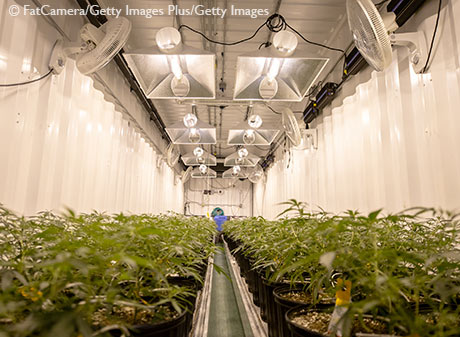Legal Marijuana Poses Policy Questions for States

In recent years, more states have legalized marijuana for medical or recreational use. This raises economic questions for policymakers as they decide how to regulate cannabis, according to a recent article in the Regional Economist.
Regional Economist Charles S. Gascon examined how states treat legal marijuana differently and whether states’ policies are aligned with economic theory.
Although federal law prohibits marijuana use, 33 states permit some form of legal cannabis for medical purposes, as of January 2020, according to Gascon. In 2012, Colorado and Washington were the first states to allow recreational use of the drug. As of January 2020, about half of the states and many local jurisdictions have decriminalized marijuana possession in varying degrees.
Cannabis consumption increased markedly in the recreational-use states, he noted. For example, Colorado’s monthly recreational sales fluctuated between $10 million and $20 million in early 2012; those sales leveled out at about $90 million a month in 2018, or about $1 billion a year (just under $200 per person annually).A portion of these sales could be to nonresidents. Reported adult usage—defined as use over the past month—jumped from 10.4% in 2011-12 to 18.1% in 2017-18.
Similarly in Washington and Oregon, adult marijuana use also spiked after legalization. About 20% of Oregon adults used cannabis at least once in the past month—the second highest usage rate in the nation in 2017-18, Gascon pointed out.For state use level, see National Survey on Drug Use and Health, State Estimates.
Nationally, marijuana use has increased slowly, moving from 7.1% in 2011-12 to 9.8% in 2017-18, he noted, adding that daily marijuana use has remained relatively constant and at low levels since 2000.
Do Policies Align with Economic Theory?
Governments that legalize marijuana anticipate added tax revenue based on sales and lower enforcement costs. But they also may need to consider inconsistent tax policies and the social costs associated with decriminalization.
“For example, states typically do not subject prescription drugs to state sales taxes, while medical marijuana has been subjected to both state sales and excise taxes,” Gascon wrote. “Therefore, medical marijuana is taxed more like alcohol or tobacco than a medical drug.”
He noted that recreational use of any drug may create social costs, including:
- Long-term health problems
- Injuries
- Accidents
- Unemployment
- Vagrancy
- Crime
Measured against these costs, the free-market price is likely too low and, therefore, consumption is too high, the author observed. Policymakers have two ways to try to reduce consumption to a socially optimal level:
- Criminal enforcement, which increases the cost of supplying drugs, reduces supply and then drives up prices.
- Taxing purchases, which raises prices and, consequently, lowers demand.
In theory, both policies could achieve the same outcome of reducing drug use to a socially optimal level, but policymakers face the difficult task of taking this theory to practice, Gascon noted.
- Enforcement requires determining the most efficient techniques and the severity of penalties while accounting for the adverse consequences of incarceration.
- Taxation requires setting the optimal tax rate, which may vary for different types of consumers. And there may be a cost of enforcing the tax on those who try to avoid payment.
“For both policies, the main challenge is determining the social cost of drug use, which ultimately determines the degree of necessary enforcement or taxation,” Gascon wrote.
The Reality
More research is needed on the economic effects of various states’ marijuana policy changes, the author noted, adding that the different policies among states provide many real-world experiments to study.
“While legal marijuana has been touted as a means for improving the fiscal position of states through lowering enforcement expenditures and generating additional tax revenue, the reality is much more complex,” Gascon wrote.
He noted that these realities include:
- The tax on medical marijuana use is inconsistent with tax policies on other drugs used in medical treatment.
- Increased tax revenue from recreational sales likely overstates the fiscal impact or may be short-lived, as consumers are likely to shift some spending to marijuana from taxable goods such as alcohol.
- Poorer individuals are generally more likely to consume products such as marijuana, alcohol, tobacco and the lottery, so “sin taxes” produce a regressive tax policy.
- The reliance on sin taxes creates an incentive to set a tax rate that maximizes revenue as opposed to a higher rate that would reduce consumption.
Notes and References
1 A portion of these sales could be to nonresidents.
2 For state use level, see National Survey on Drug Use and Health, State Estimates.
Additional Resources
- Regional Economist: As More States Legalize Marijuana, Economics Comes into Play
- On the Economy: Clarity for Banks Serving the Hemp Industry
- On the Economy: Could More Progressive Taxes Increase Income Inequality?
Citation
ldquoLegal Marijuana Poses Policy Questions for States,rdquo St. Louis Fed On the Economy, June 15, 2020.
This blog offers commentary, analysis and data from our economists and experts. Views expressed are not necessarily those of the St. Louis Fed or Federal Reserve System.
Email Us
All other blog-related questions

